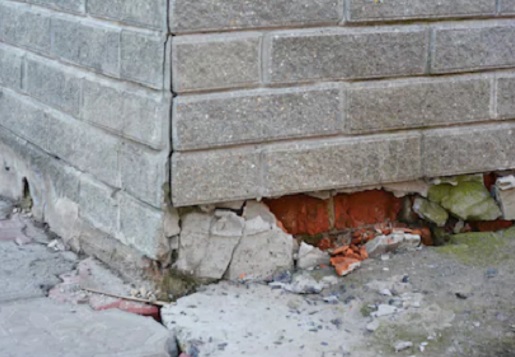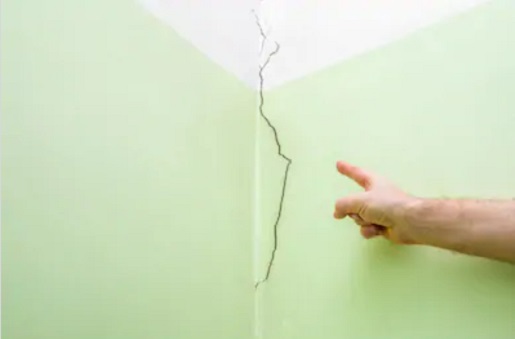No home is perfect. Every house is bound to have some maintenance issues from time to time. The key is identifying those issues and making repairs or renovations in a timely manner.
Some problems are easier to spot than others. Dripping faucets, squeaky doors, and faulty light switches are just some of the things that can be quickly remedied. Other issues can be harder to notice and more time-consuming to correct. One such concern is foundation problems.
There are many different kinds of foundation problems that can occur. Here are some of the most common ones:
1. Foundation upheaval
This occurs when the slab that your home is built on moves upward.
Excessive moisture, frost heave and plumbing leaks underneath the slab are some of the main reasons why this happens. Foundations can move anywhere from an inch or two or more over a year. This can cause significant damage to homes.

2. Uneven or sagging floors
If you’ve noticed that some of your floors tend to sag or dip, this could be a sign of foundation problems.
This could be dangerous for you and your family, especially if you have young children or elderly people living with you.
3. Cabinets and counters that are not even with walls.
Pay attention to your countertops and cabinets. Does it seem like they’re pulling farther away from the walls they’re attached to? If so, this is a tell-tale sign of house foundation problems.
When walls cease to be level, this causes these and other items in your home stop being level as well.

4. Foundation wall and floor cracks.
Gaps in your home’s exterior are indicators of foundation issues. Home foundations can shift from time to time, and small cracks of around 1/16 of an inch or less are common.
Small cracks are sometimes widened by foundation settling or moisture over time.

Larger cracks in the foundation, chimney or brick exteriors are cause for concern. If you have cracks in these or other surfaces, take some time to examine them carefully. Notice if they are vertical, horizontal or at an angle.
Cracks at a 45-degree angle are caused by a lot of movement in your home’s foundation. The sheetrock will eventually rip and tear if not replaced.
5. Gaps around window or door frames
Another sign is widening gaps around window or door frames around your home. These gaps can be large enough that doors or windows no longer close or latch properly. Door frames can also become crooked, which can cause doors to not open and close like they normally would.
6. Wet crawl spaces
If you notice more moisture in your home’s crawl spaces than normal, this could also mean that your home has foundation issues.
This is a specific concern for beam and pier homes because the additional moisture can attract termites, that can eat away at the wood in your home.
Extra water can also cause mold to form, which poses a significant health hazard for both humans and animals living in your home.

In this situation, it’s important to find the source of the moisture and take proactive steps to reduce water buildup. Adding a barrier that stops water from evaporating into the soil and making sure that you have a good drainage and ventilation system are good ways to stop things from getting worse.
7. Home sinking or settling.
Homes can sink just as easily as they can rise. Gaps in foundation settling can cause homes to sink into the ground. They can sink a few inches down or more. The longer this issue is unattended, the worse it can get.
It’s usually noticed when one side of the house starts to sink. Moisture content on each side of a home’s foundation can vary, which is why certain parts of the foundation settle before the other parts do.

Soil engineers can evaluate the ground that your home rests on to see if it was compacted correctly. Poor soil and bad or lazy construction can sometimes be to blame.
Close attention should also be paid to any sinking or settling in case the home was built on a sinkhole. This is rare, but has happened from time to time.
Homeowner Disclosure
Selling a house in Texas that has foundation problems may not be easy, but it definitely can be done. Some buyers may be in an immediate need to find a new home. Others may not mind doing a little renovation, especially if they are planning to flip the home for profit.
As the homeowner, you are legally obligated to disclose any damage the property may have. Talk to a structural engineer so that you know just how bad any foundation issues may be. You may also want to consult a company that specializes in foundation repair to receive a written estimate.
This will give you a ballpark figure on how much it should cost to correct the problem. Minor cracks shouldn’t be a big deal, but larger cracks or gaps can be costly. From there, you have two options when it comes to selling the house:
1. You could lower your asking price. If you don’t want to do the repair work yourself or hire a contractor to do it, you can always reduce the home’s selling price. You would be selling the property in “as is” condition. This may be a good option if you need to sell the property in a hurry. People in this situation frequently choose this option, especially when they have already made an offer on another home that they want to buy.
2. Pay for the repairs out of your own pocket. You could also choose to have the repairs done before putting the home up for sale. This will make your home more attractive to potential buyers and allow you to sell it at market value. Depending on market demand, you might still have to reduce your asking price slightly, but the repair work could be listed as a selling point.
Most homes experience some sort of foundation issues at one point or another. A majority of them are minor, but some of them are major. Taking the time to properly diagnose and resolve the problem can make selling the home a lot less stressful.
Don’t be afraid to call on the experts to analyze the situation and make repairs or renovations. Once you’ve taken this step, you can relax and concentrate on putting the house on the market, so that you can continue to move forward with your life goals and dreams.
Have Questions? Ask Rene!




